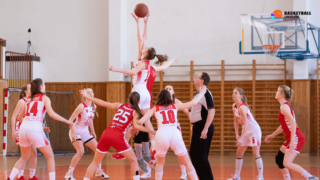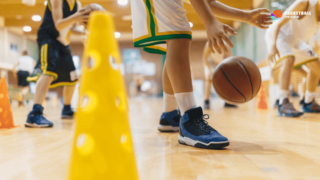
So you’re curious about the world of middle school basketball, and you’ve found yourself pondering the question, “How long is a middle school basketball game?” Well, you’ve come to the right place! In this blog post, we’ll dive headfirst into the thrilling realm of middle school hoops to help answer that burning question. While these games may lack the jaw-dropping dunks and flashy plays of the professional leagues, they’re filled with heart, passion, and budding talent in their journey through the fundamentals of the game. Ready to discover the ins and outs of middle school basketball game durations? Let’s get started and fasten your sneakers, basketball enthusiasts! It’s time to get your fun and professional dose of information!
How Long Is Middle School Basketball Game?
A typical middle school basketball game is usually around 32 minutes long, consisting of four 8-minute quarters with short breaks in between. However, the game’s total duration might vary slightly due to factors such as timeout, fouls, and halftime, which usually lasts between 5 to 10 minutes.
Timing and Structure of Middle School Basketball Games
Middle school basketball games follow a specific structure and set of rules to ensure fair competition and player development. These games are organized to provide a space for young athletes to learn the nuances of the game, hone their skills, and prepare for higher levels of competition. Here’s a detailed breakdown of the different factors affecting the length of middle school basketball games:
Quarters and Game Clock
As mentioned earlier, a standard middle school basketball game usually consists of four 8-minute quarters, summing up to a total of 32 minutes of playing time. The game clock continuously runs during play, momentarily stopping for various reasons such as dead balls, timeouts, and fouls. When there’s a stoppage in play, the game clock pauses, and once the game resumes, the clock restarts. This means that the actual duration of a middle school basketball game tends to be longer than the 32 minutes of action on the court.
Halftime and Breaks Between Quarters
A typical middle school basketball game includes a halftime break, which occurs between the second and third quarters, and usually lasts between 5 to 10 minutes. This break allows players to rest, rehydrate, and receive guidance from their coaches to strategize and adjust their game plan. Additionally, there are short breaks between the first and second quarters and the third and fourth quarters – typically lasting 1 to 2 minutes, providing players with quick opportunities to catch their breath and communicate with their teammates.
The Impact of Fouls, Timeouts, and Overtime on Game Duration
Various factors can extend the total length of a middle school basketball game beyond the 32 minutes of playing time. Let’s dive into some of these factors:
Fouls and Free Throws
Fouls are common occurrences in basketball games, and middle school games are no exception. When a player is fouled, it typically results in the game clock stopping, and depending on the type of foul, it could lead to free throws being awarded to the opposing team. Each free throw attempt takes some time, contributing to the overall length of the game. So, the more fouls committed by both teams, the longer the game stretches.
Timeouts
Each middle school team is usually allotted a specific number of timeouts per half. During a timeout, the game clock stops for a brief period (usually 30 seconds to 1 minute) allowing coaches to discuss strategies with their players, make substitutions, or give their team a much-needed breather. As each of the teams uses their timeouts, it adds more non-playing time to the game, increasing the overall duration.
Overtime
In cases where the game is tied at the end of the fourth quarter, an overtime period is played to determine the winner. Overtime periods typically last 4 minutes in middle school basketball games, with a brief break before starting. If the game is still tied after the first overtime, additional overtime periods are played until a winner emerges. Needless to say, overtime periods add more time to the overall game duration.
Developing the Fundamental Skills of Basketball
Middle school basketball provides a crucial stage in a young player’s development. While the pressure to win might be lesser compared to the high school, college, or professional levels, the focus on guiding young athletes to improve their on-court skills is immense. Let’s take a closer look at these fundamental skills:
Shooting Techniques
Shooting is an essential skill in basketball, as it is the primary means to score points. At the middle school level, players are taught various shooting techniques such as layups, jump shots, and free throws. Coaches emphasize proper shooting form, footwork, and the need for repetition to develop accuracy and consistency. With time and practice, these youngsters will transform into reliable scorers on the court.
Ball Handling and Passing
Ball handling and passing are fundamental skills that every player must learn, regardless of their position on the court. Developing strong ball-handling skills allows players to protect the ball, execute plays, and set up their teammates for scoring opportunities. Coaches invest time in teaching players various types of passes like the chest pass, bounce pass, and overhead pass, making them versatile and effective in different game situations.
Defense and Rebounding
A strong defensive game is crucial to a team’s success, and middle school coaches work on building this skill in their players. From learning the proper stance and footwork to mastering the art of defending without fouling, young players are molded into becoming effective defenders of their territory. Additionally, coaches also focus on teaching players the importance of boxing out and secure rebounds, which gives their team more possession and scoring opportunities.
Teamwork and Sportsmanship: Essential Ingredients for Success
Beyond honing their on-court abilities, players learn valuable life lessons through the middle school basketball experience. Among the most significant lessons are the importance of teamwork and sportsmanship, as basketball is a team sport that requires every member to work together effectively to achieve success.
The Power of Teamwork
Young players learn early on that to win games, they must rely on their teammates and encourage each other’s strengths. Coaches emphasize that individual talent alone won’t secure victories but rather a unified effort and effective communication between teammates. Middle school basketball serves as the bedrock for understanding the unique dynamics of working as a cohesive unit and sharing responsibilities on the court.
Embracing Sportsmanship
In addition to embracing teamwork, middle school basketball players are taught to respect their teammates, opponents, and officials – nurturing the foundations of good sportsmanship. Coaches instill the importance of playing the game with integrity, humility, and dignity. A well-rounded sportsmanship forms the blueprint for success not only in basketball but also in future life endeavors.
Preparing for the Future: Transitions to Higher Levels of Play
While middle school basketball might not have the same level of excitement or competition as higher leagues, it serves as a crucial phase in developing the next generation of talented athletes. The experience and lessons these young players acquire will help smoothen their transition to more challenging stages such as high school, college, and eventually, professional basketball.
Setting the Bar for High School Basketball
The skills and habits developed during middle school basketball serve as a solid foundation for players transitioning to the high school level. With an already-established understanding of basketball fundamentals, these athletes can focus on refining their skills, growing physically and mentally, and adapting to the more competitive environment of high school basketball.
Crafting Opportunities for Collegiate and Professional Play
For those aspiring to play college or professional basketball, middle school becomes the first step in a long and arduous journey. The dedication, hard work, and discipline they cultivate during this phase of their basketball career will stay with them as they navigate through higher levels of the sport. With resilience and perseverance, these talented youngsters might someday grace the courts of college and professional basketball arenas, achieving their dreams while creating unforgettable moments for their fans.
Maximizing the Middle School Basketball Experience
Middle school basketball is an excellent opportunity for young athletes to embrace their passion for the game, develop fundamental skills, and create lifelong memories with their teammates. To make the most out of this unique experience, whether you’re a player or a supportive parent, consider the following recommendations:
Encourage and Support Your Young Athletes
One of the most crucial roles for parents to play is showing unwavering support and encouragement to their child’s sporting pursuits. Attend games, cheer them on, and acknowledge their efforts and improvements regardless of the final scores. A healthy and nurturing environment fosters better learning, growth, and also builds a strong bond between you and your young athlete.
Emphasize the Importance of Practice
Middle school players should be constantly reminded of the importance of perfecting their craft. Encourage them to invest time in honing their skills, whether it be shooting, dribbling, or defense, through diligent practice sessions. Enrolling them in supplementary basketball camps and clinics can also give them a competitive edge and better understanding of the game’s intricacies.
Importance of Physical Fitness and Nutrition
Young basketball players must grasp the significance of maintaining sound physical health and following a nutritious diet. Eating healthy meals, staying hydrated, and adhering to a consistent exercise regimen are fundamental aspects of achieving peak performance on the court. It’s essential for parents to take an active role in guiding their child towards a balanced and healthy lifestyle that caters to the physical demands of basketball.
Understanding the Role of Coaches and Referees
Another vital aspect of the middle school basketball experience is developing a strong relationship and respect for coaches and referees. Coaches are there to mentor, motivate, and guide players through their basketball journey, while referees maintain a safe and fair game environment. Young athletes should appreciate their roles and display respect and gratitude for their guidance and expertise.
Getting Involved in Middle School Basketball
If you feel that your child could benefit from becoming a part of a middle school basketball team or if you’re interested in volunteering as a coach, here are some helpful suggestions:
Finding a Local Middle School Basketball Team
First, check with your child’s school to see if they offer a basketball program. If not, investigate other community-based programs or leagues that cater to middle school-aged players, such as the local YMCA, parks and recreation departments, or Amateur Athletic Union (AAU) events. These organizations typically offer team opportunities and skill development programs, giving young players a chance to participate and grow in a structured environment.
Volunteering as a Coach or Assistant
If you have a passion for the game and seek to make a positive impact on young athletes, consider volunteering as a coach or assistant for a middle school basketball team. Many schools and community programs are continuously searching for dedicated individuals to mentor and support their players. While previous experience in basketball may be advantageous, a willingness to learn and a genuine interest in the players’ well-being and development are the most valuable assets you can bring to the team.
In conclusion, middle school basketball games not only enhance the athletic prowess of aspiring basketball players but also teach them valuable life lessons, like teamwork and sportsmanship. The unique experience they gain during this period shapes them as athletes and individuals and sets the foundation for future success in their basketball careers and beyond.
Frequently Asked Questions About Middle School Basketball Games
If you’re still seeking more insights about middle school basketball games, don’t worry – we’ve got you covered! Here’s a compilation of the most common questions and straightforward answers to help enrich your understanding of this fascinating topic:
1. Are there any specific rules for middle school basketball games?
Yes, middle school basketball games follow a set of rules, which are generally based on the National Federation of State High School Associations (NFHS) guidelines, with minor modifications to cater to younger players. The specific rule adjustments may vary depending on the school league or local basketball organization.
2. What’s the size of a middle school basketball court?
A typical middle school basketball court measures 74 feet in length and 42 feet in width. However, the exact dimensions may differ slightly, depending on the facility or local basketball organization regulations.
3. How many players can be on a middle school basketball team?
While there’s no strict rule, most middle school basketball teams generally roster between 12 to 15 players. This number can vary based on factors such as school or league-specific regulations and the availability of players.
4. Do girls and boys play in separate middle school basketball leagues?
Yes, middle school basketball is typically organized into separate leagues or divisions for girls and boys. This ensures more balanced competition and provides development opportunities for both genders.
5. Can my child engage in basketball training outside of their middle school team?
Yes, young athletes can benefit from additional basketball training outside of their school team. Supplemental training, such as camps, clinics, and private coaching, can help them refine their skills and gain a competitive edge on the court.
6. What kind of footwear is recommended for middle school basketball games?
It’s essential to wear appropriate basketball shoes that provide ankle support, traction, and cushioning for optimal performance and injury prevention. Ensure the shoes fit comfortably and are specifically designed for basketball use.
7. How do middle school teams qualify for playoffs and championships?
Teams typically qualify for playoffs and championships based on their regular-season win-loss records and standings within their respective leagues. Specific qualification criteria may vary depending on the league or basketball organization.
8. How does middle school basketball prepare players for high school basketball?
Middle school basketball helps players develop foundational skills, understand teamwork, and embrace sportsmanship. These experiences and lessons set the stage for a smoother transition to the more competitive environment of high school basketball.
9. Are there specific age limits for middle school basketball players?
Middle school basketball usually caters to students in grades 6 through 8, approximately aged between 11 and 14. However, age requirements may vary based on the specific school or basketball organization’s policies.
10. How can middle school players best balance academics with their basketball commitments?
To successfully juggle academics and basketball, young athletes should prioritize time management, develop effective study habits, and set clear goals. Communication with parents, coaches, and teachers is also essential to address any potential academic or athletic concerns.
11. Can middle school players get scouted or recruited early for high school and college basketball teams?
While early scouting or recruitment is less common in middle school basketball compared to high school, exceptional talents may receive attention from high school and college programs. However, players should primarily focus on improving their skills, academics, and character attributes to prepare for future opportunities.
12. What is the role of parents in supporting their child’s middle school basketball journey?
Parents should encourage and support their child’s athletic endeavors by attending games, acknowledging their efforts and improvements, nurturing a healthy lifestyle, and guiding them in balancing academic and athletic commitments.
13. How can I volunteer for my child’s middle school basketball team?
Volunteering opportunities can include coaching, team administration, scorekeeping, or event organization. Contact your child’s school, the basketball program, or the community league to inquire about available volunteer roles and requirements.
Featured Posts
- No pillar pages found.





